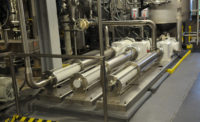Making the most of progressing cavity pumps in difficult food, beverage applications

Though progressing cavity pumps are not the most common pumps used for conveyance in food and beverage production, certain applications, such as those requiring high pressure or conveying highly viscous media, require this pump type. Progressing cavity pumps can be well suited to food and beverage applications’ needs regarding contamination avoidance, but require an additional pump be included in the system for effective clean-in-place (CIP) procedures. With the right system design, progressing cavity pumps can reduce cost, lower maintenance needs and achieve better results in complex conveying applications within food and beverage production.
Certain applications demand progressing cavity pumps
Where food and beverage pumping applications are concerned, progressing cavity pumps are rarely the first thought in system design. Rotary lobe and centrifugal pumps are far more commonly used in these applications. In many situations, however, rotary lobe and centrifugal pumps are not up to the task of conveyance in food and beverage applications.
Progressing cavity pumps are capable of handling higher pressures and higher viscosity materials than either rotary lobe or centrifugal pumps. Cost savings of up to 50% are possible with progressing cavity pumps over rotary lobe pumps, especially in smaller volume operations. In addition, in applications where media is under high pressure (>100psi) or of high viscosity (>20,000 cP for rotary lobe; >10,000 cP for centrifugal), progressing cavity pumps are far better suited than the alternatives. The choice in not so clear-cut for applications requiring an extremely small footprint; in these cases, designers must balance the need for high pressure or high viscosities with available space and determine the best solution.
In the end, progressing cavity pumps are ideal for conveyance tasks in a number of food and beverage production environments, especially those with difficult-to-convey, shear-sensitive, abrasive and/or viscous components. The pumping process in progressing cavity pumps involves a rotor turning with an eccentric rotary motion within a fixed stator. The two components are precisely geometrically mated with one another, conveying chambers are formed between them and these chambers advance during rotation. The medium is gently transported in these chambers from the inlet to the discharge side by the turning motion. Volume and pressure remain constant with progressing cavity pump technology, regardless of the viscosity or consistency of the substance being conveyed. In addition, no shear forces, pulsation or pressure reversal points occur, thus avoiding damage to the medium.
In food and beverage applications specifically, progressing cavity pumps can be designed to reduce the risk of contamination. In order to do so, pumps must use FDA-approved materials, including metals, plastics and elastomers, with each elastomer compound independently tested to determine suitability. Depending on the material being conveyed, certification may be required for pump systems and processes in food and beverage applications.
Making CIP work in PC/PD pumps
Incorporating progressing cavity and other similar positive displacement pumps into food and beverage pumping applications brings up the question of sanitization and CIP processes. While rotary lobe and centrifugal pumps allow for CIP processes directly through the existing pumping technology, progressing cavity and other positive displacement pumps require a separate pump to enable CIP processes. This does not make them unsuited to the task; it simply requires some additional concern in the initial system design.
CIP procedures are critically important in food and beverage conveying applications because proper pump and pipe cleaning is key to avoiding contamination, bacterial growth and other issues. Running a cleaning agent (acid, caustic or even just water at high temperatures through the pump system) helps to ensure proper cleaning and meets regulatory requirements.
Usually with rotary lobe and centrifugal pump systems, there is no need for a separate CIP pump. The pump in use can be used as a CIP pump for cleaning by simply running the proper CIP solution in place of the usual food or beverage media. It is often easier to disassemble these types of pumps for cleaning than progressing cavity pumps; while rotary lobe and centrifugal pumps can be disassembled for cleaning without disconnecting piping, progressing cavity pumps must be fully disassembled, including the rotor and stator to perform manual cleaning tasks. Running CIP processes can limit the amount of cleaning that must be done with pump disassembly, though with progressing cavity pumps, this requires a small, separate pump.
Given that the suction body of the progressing cavity pump is larger (typically about twice the diameter) of the surrounding piping, there is a velocity drop of the cleaning solution within the suction body if the progressing cavity pump is used for CIP procedures. As a result, the cleaning solution does not achieve the proper velocity throughout the system, and the CIP process is not successful. Using a separate pump achieves proper velocity and CIP processes are successful. Typically, these separate pumps are small centrifugal pumps, as the cleaning solutions used for CIP are low viscosity. Using this pump to achieve successful CIP procedures assures cleanliness, along with successful, efficient pumping of difficult media in the actual production process via the progressing cavity pump.
Benefits of well-designed pumping technology
It is important to take cleaning into account when the pumping system is first designed. The rotor of the progressing cavity pump should be designed to be compatible not only for the media and temperature range of the process, but also for compatibility with the chemicals being used in the CIP process and their temperature. CIP processes can change, and when they do, compatibility with the stator elastomer should be verified and the stator or cleaning solution replaced if necessary.
Given that a separate CIP pump is required for systems that include progressing cavity pumps, it is also important that the progressing cavity pump design have the appropriate bypass setup, as well as suction and discharge ports that allow for the addition of a separate pump.
Working with experts to assess the needs of any food and beverage pumping application, choosing the best pump for the media being conveyed and designing a system that allows for effective cleaning of that ideal pump ensures sanitary processes fit a company’s budget, plant footprint and regulatory requirements. CIP procedures should be clearly understood when choosing pump systems, but equipment like progressing cavity pumps that can’t provide a dual function as CIP pumps can nevertheless be well suited to sanitary applications like those in food and beverage conveyance. The right pump design along with fine-tuning to the final system ensures that media is conveyed appropriately, maintenance needs are reduced and contamination is avoided.
Looking for a reprint of this article?
From high-res PDFs to custom plaques, order your copy today!






